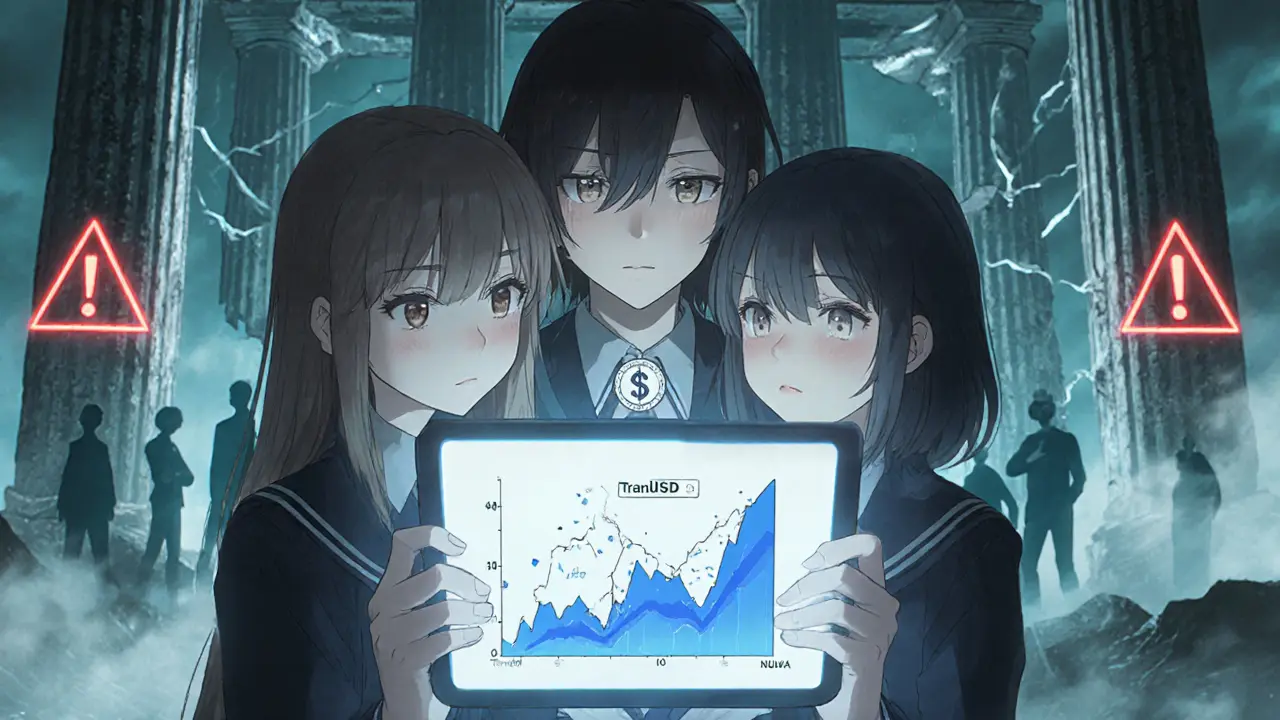Stablecoin Risk Assessment Tool
Stablecoin Risk Assessment
Check the stability risk of popular stablecoins based on reserve quality, audit transparency, and historical performance.
Risk Assessment Results
Based on reserve quality, audit transparency, and historical stability.
Important: This tool evaluates historical risk factors only. Stablecoin risks can change rapidly.
When a stablecoin drops to $0.95, $0.90, or worse - even though it’s supposed to be worth exactly $1 - something has gone very wrong. This isn’t a glitch. It’s a depegging, and it’s one of the most dangerous events in crypto. Unlike Bitcoin or Ethereum, which swing by design, stablecoins are built to be steady. They’re meant to be the anchor in a stormy market. But when that anchor breaks, the whole system can shudder.
What Exactly Is a Stablecoin Depeg?
A stablecoin depeg happens when a digital token that’s supposed to hold a 1:1 value with a real-world asset - usually the US dollar - loses that connection. You might see USDT trading at $0.97. Or USDC at $0.92. In extreme cases, like TerraUSD in 2022, it plunged to pennies. The peg isn’t just a suggestion. It’s the whole reason these coins exist. Without it, they lose their purpose: a safe harbor for traders, a stable unit of account in DeFi, or a bridge between crypto and traditional finance.
Most stablecoins are supposed to be backed by reserves. That means for every $1 of USDC or USDT issued, there should be $1 in cash, treasury bills, or other safe assets sitting in a bank. But here’s the catch: not all issuers keep those reserves in the same place. Some use risky investments. Some use other crypto assets. And when markets turn, those assets can crash - dragging the stablecoin down with them.
The TerraUSD Collapse: A Perfect Storm
The biggest depegging in crypto history didn’t come from a bank failure or a hack. It came from a flawed algorithm.
TerraUSD (UST) wasn’t backed by dollars. It was an algorithmic stablecoin - meaning it used another token, LUNA, to maintain its peg. When UST dropped below $1, the system would burn LUNA and mint more UST to bring the price back up. Or so the theory went.
In May 2022, large holders started selling UST. The market couldn’t absorb the sell-off. As UST dipped to $0.98, then $0.95, panic spread. People rushed to swap UST for other stablecoins. The algorithm couldn’t keep up. LUNA’s value collapsed. Within days, UST was worth less than 10 cents. LUNA went from a $40 billion project to nearly worthless.
This wasn’t just a price drop. It was a total system failure. UST never recovered. The algorithm didn’t fix itself - it destroyed itself. And the fallout rippled across crypto. Entire DeFi protocols that used UST as collateral lost billions. Investors lost trust. Markets tumbled. The event proved that algorithmic stablecoins, without real-world backing, are fundamentally unstable under pressure.
Tether’s Long Shadow: When Backing Isn’t Transparent
While UST died, Tether (USDT) survived - barely. It’s the most used stablecoin in the world, with over $100 billion in circulation. But its history is full of red flags.
In 2021, the U.S. Commodity Futures Trading Commission (CFTC) fined Tether $41 million for misleading claims about its reserves. The company said it held $1 in cash for every USDT. It didn’t. Much of its backing was in commercial paper, corporate bonds, and even risky loans. These aren’t safe assets. They’re not cash. And they can’t be sold quickly if everyone tries to cash out at once.
Tether still hasn’t fully transitioned to holding only cash and Treasury bills. Even today, a significant portion of its reserves are in illiquid or low-grade assets. That’s a ticking clock. If a major bank fails, or if interest rates spike, those assets could lose value - and USDT could depeg again.
Unlike UST, USDT hasn’t collapsed. But that’s not because it’s safe. It’s because users still trust it - for now. And trust is fragile.

Why Depegging Happens: The Real Causes
Depegging isn’t random. It follows patterns.
- Market panic: When Bitcoin crashes, people sell everything - including stablecoins. If too many want to cash out at once, the issuer can’t keep up.
- Bad collateral: If a stablecoin’s reserves are tied to corporate debt, real estate, or other crypto, a drop in those assets = a drop in the peg.
- Lack of audits: If no independent firm checks the reserves regularly, you’re trusting a black box.
- Regulatory threats: When regulators threaten to shut down a stablecoin issuer (like Binance’s BUSD in 2023), holders panic and sell.
- Network congestion: If the blockchain gets jammed, redemptions get delayed. That looks like a depeg - even if the issuer is fine.
Here’s the brutal truth: most stablecoins are only as stable as their weakest asset. And that asset is often not cash.
Who Gets Hurt When a Stablecoin Depegs?
It’s not just the people holding the coin.
When USDT drops to $0.95, traders on exchanges lose money. DeFi protocols that use it as collateral get liquidated. Lenders can’t get repaid. Borrowers get wiped out. Even centralized exchanges suffer - users withdraw funds, liquidity dries up, and trading slows.
And it doesn’t stop there. Traditional finance starts to feel the heat. Banks that hold stablecoins as deposits see sudden outflows. Money market funds get spooked. The whole system becomes more volatile.
Stablecoins were supposed to reduce risk. But when they depeg, they become the source of it.

How to Spot a Risky Stablecoin
Not all stablecoins are created equal. Here’s how to tell the safe ones from the dangerous ones:
- Check the backing: Is it 100% cash and Treasury bills? Or is it a mix of crypto, bonds, and loans?
- Look for audits: Does an independent firm like Grant Thornton or BDO publish monthly reserve reports?
- See the redemption rights: Can you actually exchange your stablecoin for dollars anytime? Or are there hidden delays?
- Watch the price: If a stablecoin trades at $0.99 for days, that’s a warning. It’s not broken - it’s under stress.
- Know the issuer: Is it a well-known company with legal oversight? Or a startup with no clear legal structure?
USDC, issued by Circle, is one of the most transparent. It publishes daily reserve reports and holds almost all assets in cash and U.S. Treasuries. DAI, while partially crypto-backed, is overcollateralized and governed by a decentralized community. Both are far safer than most others.
The Future: Regulation Is Coming - But Is It Enough?
After UST and BUSD’s shutdown, regulators are stepping in. The U.S. is pushing for strict reserve rules. The EU’s MiCA law requires stablecoin issuers to hold 100% reserves in high-quality liquid assets. Other countries are following.
But regulation moves slow. Crypto moves fast. And many issuers still operate in gray areas. Even if new rules pass, enforcement is uncertain. And what happens when a stablecoin issuer goes bankrupt? Who gets paid first - the stablecoin holders, or the bondholders?
Until legal frameworks clearly protect stablecoin holders as depositors - not just token holders - the risk remains.
What Should You Do?
If you’re using stablecoins for trading, lending, or storing value:
- Stick to USDC or DAI. Avoid lesser-known stablecoins.
- Don’t keep large amounts in any stablecoin for long periods. Treat them like cash - useful, but not permanent storage.
- Watch the price. If it’s consistently below $1, get out.
- Understand what backs it. If you can’t find clear reserve reports, assume it’s risky.
- Never assume stability. Even the biggest stablecoins can fail.
Stablecoins are tools. Not savings accounts. Not banks. Not insurance. And until they’re treated like regulated financial products, they’ll always carry risk.
What causes a stablecoin to depeg?
A stablecoin depegs when market pressure, loss of confidence, insufficient reserves, or technical flaws cause its value to drop below its intended peg - usually $1. Common triggers include panic selling, poor collateral backing, regulatory threats, or algorithmic failures like in the TerraUSD collapse.
Which stablecoins are safest?
USDC and DAI are currently the safest. USDC is fully backed by cash and U.S. Treasury bills, with daily public audits. DAI is overcollateralized with crypto assets and governed by a decentralized community. Both have strong transparency and low depegging history.
Did USDT ever depeg?
Yes. USDT has depegged multiple times - most notably in March 2023 during the Silicon Valley Bank collapse, when it briefly fell to $0.95. It recovered quickly, but the event exposed its reliance on risky assets. Tether has never fully transitioned to 100% cash reserves.
Can a stablecoin recover from a depeg?
Sometimes. USDT and USDC have recovered from minor depegs by using reserve assets to buy back tokens. But algorithmic stablecoins like UST cannot recover - their design is broken. Once confidence is lost, they collapse permanently.
Is it safe to use stablecoins in DeFi?
Only if you know what backs them. USDC and DAI are widely used and trusted in DeFi. Avoid lesser-known stablecoins, especially those without clear audits or transparent reserves. Always assume there’s risk - even with the best stablecoins.


Bruce Murray
November 17, 2025 AT 10:50Stablecoins are like umbrellas in a storm-you only notice them when they flip inside out.
Carol Wyss
November 18, 2025 AT 04:20I’ve held USDC for years and never had a hiccup. But I always keep a little in ETH too-just in case the whole house of cards gets a breeze.
Henry Lu
November 20, 2025 AT 02:03USDT is still alive? lol. Tether’s reserves are basically a PowerPoint slide from 2018 with "crypto assets" scribbled in Comic Sans. Someone call the SEC before this turns into a TikTok trend.
Sean Pollock
November 20, 2025 AT 16:01People still think stablecoins are safe? Bro. It’s not about the peg-it’s about who’s holding the keys. If you’re not auditing the issuer like you’re checking your ex’s phone, you’re already dead money.
nikhil .m445
November 21, 2025 AT 07:00Actually, in India we use USDT more than USD because banks are slow. But I always check price on Binance before withdrawing. If it’s below 0.99, I wait. Simple.